High-Resolution Mining-Induced Geo-Hazard Mapping Using Random Forest: A Case Study of Liaojiaping Orefield, Central China
Abstract
:1. Introduction
2. Study Area and Materials
2.1. Geological Setting
2.2. Geological Disasters
2.3. Multi-Source Geo-Environmental Data
3. Methodology
3.1. GF-1 Image Processing
3.1.1. Band Ratio Operation
3.1.2. Image Transformations
3.1.3. Filtering
3.2. RF-Based Classification Scheme and Prediction Model
3.2.1. RF Background
3.2.2. RF-Based Classifier
3.3. Sample-Improved WofE Method
4. Results
4.1. Land Cover Mapping
4.2. Mining-Induced Geo-Hazard Mapping (MGM)
5. Discussion
5.1. Importance of the Feature Variable
5.2. Correlation of the Predictive Factors with MG Occurrence
5.3. MG Monitoring and Pre-Warning
6. Conclusions
Author Contributions
Funding
Acknowledgments
Conflicts of Interest
References
- Marschalko, M.; Yilmaz, I.; Křístková, V.; Fuka, M.; Kubečka, K.; Bouchal, T. An indicative method for determination of the most hazardous changes in slopes of the subsidence basins in underground coal mining area in Ostrava (Czech Republic). Environ. Monit. Assess. 2013, 185, 509–522. [Google Scholar] [CrossRef]
- Yang, Y.Y.; Xu, Y.S.; Shen, S.L.; Yuan, Y.; Yin, Z.Y. Mining-induced geo-hazards with environmental protection measures in Yunnan, China: An overview. Bull. Eng. Geol. Environ. 2015, 74, 141–150. [Google Scholar] [CrossRef]
- Li, S.L. Study on the geological hazard in metal mines and its prevention countermeasures. Chin. J. Geol. Hazard Control 2002, 46–50+54, (In Chinese with English Abstract). [Google Scholar]
- Yi, H.P.; Jiang, Z. Causes and prevention measures of mine geological disasters. Sci. Technol. Innov. Her. 2010, 4, 126. (In Chinese) [Google Scholar]
- Fan, L.M.; Li, C.; Chen, J.P.; Ning, J.M. Geological hazards and prevention technology in high-intensity mining area of mineral resources. Sci. Press 2016, 28, 8. (In Chinese) [Google Scholar]
- Liu, L.; Chen, L.Q.; Tang, J.X. Present Situation and Future Prospects of Geologic Environment Issues in Mines in China. Disaster Adv. 2010, 3, 563–566. [Google Scholar]
- Shao, L.F. Geological disaster prevention and control and resource protection in mineral resource exploitation region. Int. J. Low-Carbon Technol. 2019, 14, 142. [Google Scholar] [CrossRef] [Green Version]
- Xu, Y.N. Investigation and research on the mine geological environment: Present status and outlook. Geol. Bull. China 2008, 27, 1235–1244, (In Chinese with English Abstract). [Google Scholar]
- Chowdhury, R.; Flentje, P. Role of slope reliability analysis in landslide risk management. Bull. Eng. Geol. Environ. 2003, 62, 41–46. [Google Scholar] [CrossRef]
- Romeo, R.W.; Floris, M.; Veneri, F. Area-scale landslide hazard and risk assessment. Environ. Geol. 2006, 51, 1–13. [Google Scholar] [CrossRef]
- Huang, R.Q.; Li, W.L. Analysis of the geo-hazards triggered by the 12 May 2008 Wenchuan earthquake, China. Bull. Eng. Geol. Environ. 2009, 68, 363–371. [Google Scholar] [CrossRef]
- Chen, K.T.; Wu, J.H. Simulating the failure process of the xinmo landslide using discontinuous deformation analysis. Eng. Geol. 2018, 239, 269–281. [Google Scholar] [CrossRef]
- Wang, Q.J.; Guo, H.D.; Chen, Y.; Lin, Q.Z.; Li, H. Application of remote sensing for investigating mining geological hazards. Int. J. Digit. Earth 2013, 6, 449–468. [Google Scholar] [CrossRef]
- Segoni, S.; Pappafico, G.; Luti, T.; Catani, F. Landslide susceptibility assessment in complex geological settings: Sensitivity to geological information and insights on its parameterization. Landslides 2020, 17, 2443–2453. [Google Scholar] [CrossRef] [Green Version]
- Ahmad, H.; Chen, N.S.; Rahman, M.; Islam, M.M.; Pourghasemi, H.R.; Habumugisha, J.M. Geohazards Susceptibility Assessment along the Upper Indus Basin Using Four Machine Learning and Statistical Models. ISPRS Int. J. Geo-Inf. 2021, 10, 315. [Google Scholar] [CrossRef]
- Westen, C.J.V.; Castellanos, E.; Kuriakose, S.L. Spatial data for landslide susceptibility, hazard, and vulnerability assessment: An overview. Eng. Geol. 2008, 102, 112–131. [Google Scholar] [CrossRef]
- Lu, P.; Catani, F.; Tofani, V.; Casagli, N. Quantitative hazard and risk assessment for slow-moving landslides from persistent scatterer interferometry. Landslides 2014, 11, 685–696. [Google Scholar] [CrossRef]
- Pavlova, I.; Makarigakis, A.; Depret, T.; Jomelli, V. Global overview of the geological hazard exposure and disaster risk awareness at world heritage sites. J. Cult. Herit. 2017, 28, 8445–8452. [Google Scholar] [CrossRef]
- Vaziri, V.; Hamidi, J.K.; Sayadi, A.R. An integrated GIS-based approach for geohazards risk assessment in coal mines. Environ. Earth Sci. 2018, 77, 29. [Google Scholar] [CrossRef]
- Mohammady, M.; Pourghasemi, H.R.; Amiri, M. Assessment of land subsidence susceptibility in Semnan plain (Iran): A comparison of support vector machine and weights of evidence data mining algorithms. Nat. Hazards 2019, 99, 951–971. [Google Scholar] [CrossRef]
- Hemasinghe, H.; Rangali, R.S.; Deshapriya, N.L.; Samarakoon, L. Landslide susceptibility mapping using logistic regression model (a case study in Badulla District, Sri Lanka). Procedia Eng. 2018, 212, 1046–1053. [Google Scholar] [CrossRef]
- Lee, H.; Oh, J. Establishing an ANN-Based Risk Model for Ground Subsidence Along Railways. Appl. Sci. 2018, 8, 1936. [Google Scholar] [CrossRef] [Green Version]
- Youssef, A.M.; Pourghasemi, H.R.; Pourtaghi, Z.S.; Al-Katheeri, M.M. Landslide susceptibility mapping using random forest, boosted regression tree, classification and regression tree, and general linear models and comparison of their performance at Wadi Tayyah Basin, Asir Region, Saudi Arabia. Landslides 2016, 13, 839–856. [Google Scholar] [CrossRef]
- Zhang, K.X.; Wu, X.L.; Niu, R.Q.; Yang, K.; Zhao, L.R. The assessment of landslide susceptibility mapping using random forest and decision tree methods in the Three Gorges Reservoir area, China. Environ. Earth Sci. 2017, 76, 405. [Google Scholar] [CrossRef]
- Kim, K.D.; Lee, S.; Oh, H.J.; Choi, J.K.; Won, J.S. Assessment of ground subsidence hazard near an abandoned underground coal mine using GIS. Environ. Geol. 2006, 50, 1183–1191. [Google Scholar] [CrossRef]
- Sharma, S.; Mahajan, A.K. A comparative assessment of information value, frequency ratio and analytical hierarchy process models for landslide susceptibility mapping of a Himalayan watershed, India. Bull. Eng. Geol. Environ. 2019, 78, 2431–2448. [Google Scholar] [CrossRef]
- Zhou, X.T.; Wu, W.C.; Lin, Z.Y.; Zhang, G.L.; Chen, R.X.; Song, Y.; Wang, Z.L.; Lang, T.; Qin, Y.Z.; Ou, P.H.; et al. Zonation of Landslide Susceptibility in Ruijin, Jiangxi, China. Int. J. Environ. Res. Public Health 2021, 18, 5906. [Google Scholar] [CrossRef] [PubMed]
- Cracknell, M.J.; Reading, A.M. Geological mapping using remote sensing data: A comparison of five machine learning algorithms, their response to variations in the spatial distribution of training data and the use of explicit spatial information. Comput. Geosci. 2014, 63, 22–33. [Google Scholar] [CrossRef] [Green Version]
- Carranza, E.J.M.; Laborte, A.G. Random Forest predictive modeling of mineral prospectivity with small number of prospects and data with missing values in Abra (Philippines). Comput. Geosci. 2015, 74, 60–70. [Google Scholar] [CrossRef]
- Li, X.H. Using “random forest” for classification and regression. Chin. J. Appl. Entomol. 2016, 50, 1190–1197. [Google Scholar]
- Qin, Y.Z.; Liu, L.M. Quantitative 3D Association of Geological Factors and Geophysical Fields with Mineralization and Its Significance for Ore Prediction: An Example from Anqing Orefield, China. Minerals 2018, 8, 300. [Google Scholar] [CrossRef] [Green Version]
- Wu, W.C.; Zucca, C.; Muhaimeed, A.S.; Alshafie, W.M.; Alquraish, A.M.F.; Nangia, V.; Zhu, M.Q.; Liu, G.P. Soil salinity prediction and mapping by machine learning regression in Central Mesopotamia. Land Degrad. Dev. 2018, 29, 4005–4014. [Google Scholar] [CrossRef]
- Sun, T.; Li, H.; Wu, K.; Chen, F.; Zhu, Z.; Hu, Z. Data-Driven Predictive Modelling of Mineral Prospectivity Using Machine Learning and Deep Learning Methods: A Case Study from Southern Jiangxi Province, China. Minerals 2020, 10, 102. [Google Scholar] [CrossRef] [Green Version]
- Cao, J.; Zhang, Z.; Du, J.; Zhang, L.; Song, Y.; Sun, G. Multi-geohazards susceptibility mapping based on machine learning—A case study in Jiuzhaigou, China. Nat. Hazards 2020, 102, 851–871. [Google Scholar] [CrossRef]
- Magidi, J.; Nhamo, L.; Mpandeli, S.; Mabhaudhi, T. Application of the Random Forest Classifier to Map Irrigated Areas Using Google Earth Engine. Remote Sens. 2021, 13, 876. [Google Scholar] [CrossRef]
- Choi, W.; Lee, H.; Kim, D.; Kim, S. Improving Spatial Coverage of Satellite Aerosol Classification Using a Random Forest Model. Remote Sens. 2021, 13, 1268. [Google Scholar] [CrossRef]
- Qin, Y.Z.; Liu, L.M.; Wu, W.C. Machine Learning-Based 3D Modeling of Mineral Prospectivity Mapping in the Anqing Orefield, Eastern China. Nat. Resour. Res. 2021. [Google Scholar] [CrossRef]
- Youssef, A.M.; Pourghasemi, H.R. Landslide susceptibility mapping using machine learning algorithms and comparison of their performance at Abha Basin, Asir Region, Saudi Arabia. Geosci. Front. 2021, 12, 639–655. [Google Scholar] [CrossRef]
- Shao, L.; Li, J. Geological hazards types induced by mining and their characteristics in Guizhou province. Chin. J. Geol. Hazards Control. 2011, 22, 56–60, (In Chinese with English Abstract). [Google Scholar]
- Kong, F.J.; Li, X.B.; Hong, W.; Xie, D.F.; Li, X.; Bai, Y.X. Land cover classification based on fused data from gf-1 and modis ndvi time series. Remote Sens. 2016, 8, 741. [Google Scholar] [CrossRef] [Green Version]
- Yang, C.; Wu, G.F.; Kai, D.; Shi, T.Z.; Li, Q.Q.; Wang, J.L. Improving land use/land cover classification by integrating pixel unmixing and decision tree methods. Remote Sens. 2017, 9, 1222. [Google Scholar] [CrossRef] [Green Version]
- Akbari, E.; Boloorani, A.D.; Samany, N.N.; Hamzeh, S.; Soufizadeh, S.; Pignatti, S. Crop Mapping Using Random Forest and Particle Swarm Optimization based on Multi-Temporal Sentinel-2. Remote Sens. 2020, 12, 1449. [Google Scholar] [CrossRef]
- Youssef, A.M. Landslide susceptibility delineation in the Ar-Rayth area, Jizan, Kingdom of Saudi Arabia, using analytical hierarchy process, frequency ratio, and logistic regression models. Environ. Earth Sci. 2015, 73, 8499–8518. [Google Scholar] [CrossRef]
- Pachuau, L. Zonation of Landslide Susceptibility and Risk Assessment in Serchhip town, Mizoram. J. Indian Soc. Remote Sens. 2019, 47, 1587–1597. [Google Scholar] [CrossRef]
- Arabameri, A.; Pradhan, B.; Rezaei, K.; Lee, C.W. Assessment of Landslide Susceptibility Using Statistical- and Artificial Intelligence-Based FR-RF Integrated Model and Multiresolution DEMs. Remote Sens. 2019, 11, 999. [Google Scholar] [CrossRef] [Green Version]
- Zhang, Y.; Wu, W.C.; Qin, Y.Z.; Lin, Z.Y.; Zhang, G.L.; Chen, R.X.; Song, Y.; Lang, T.; Zhou, X.T.; Huangfu, W.C.; et al. Mapping Landslide Hazard Risk Using Random Forest Algorithm in Guixi, Jiangxi, China. Int. J. Geo-Inf. 2020, 9, 695. [Google Scholar] [CrossRef]
- Ou, P.H.; Wu, W.C.; Qin, Y.Z.; Zhou, X.T.; Huangfu, W.C.; Zhang, Y.; Xie, L.F.; Fu, X.; Li, J.; Jiang, J.H.; et al. Assessment of landslide hazard in jiangxi using geo-information. Front. Earth Sci. China 2021, 9, 648342. [Google Scholar] [CrossRef]
- Micheletti, N.; Foresti, L.; Robert, S.; Leuenberger, M.; Pedrazzini, A.; Jaboyedoff, M.; Kanevski, M. Machine Learning Feature Selection Methods for Landslide Susceptibility Mapping. Math. Geosci. 2014, 46, 33–57. [Google Scholar] [CrossRef] [Green Version]
- Bai, Z.G. Technical characteristics of the Gaofen-1 Satellite. Aerosp. China 2013, 8, 5–9. (In Chinese) [Google Scholar]
- Gao, H.L.; Gu, X.F.; Yu, T.; Sun, Y.; Xie, Y.; Liu, Q.Y. Validation of the calibration coefficient of the gaofen-1 pms sensor using the landsat 8 oli. Remote. Sens. 2016, 8, 132. [Google Scholar] [CrossRef] [Green Version]
- Goetz, J.N.; Brenning, A.; Petschko, H.; Leopold, P. Evaluating machine learning and statistical prediction techniques for landslide susceptibility modeling. Comput. Geosci. 2015, 81, 1–11. [Google Scholar] [CrossRef]
- Moosavi, V.; Niazi, Y. Development of hybrid wavelet packet-statistical models (WP-SM) for landslide susceptibility mapping. Landslides 2016, 13, 97–114. [Google Scholar] [CrossRef]
- Dou, J.; Yunus, A.P.; Bui, D.T.; Merghadi, A.; Sahana, M.; Zhu, Z.F.; Chen, C.W.; Khosravi, K.; Yang, Y.; Pham, B.T. Assessment of advanced random forest and decision tree algorithms for modeling rainfall-induced landslide susceptibility in the Izu-Oshima Volcanic Island, Japan. Sci. Total Environ. 2019, 662, 332–346. [Google Scholar] [CrossRef]
- Kalantar, B.; Pradhan, B.; Naghibi, S.A.; Motevalli, A.; Mansor, S. Assessment of the effects of training data selection on the landslide susceptibility mapping: A comparison between support vector machine (SVM), logistic regression (LR) and artificial neural networks (ANN). Geomat. Nat. Hazards Risk 2018, 9, 49–69. [Google Scholar] [CrossRef]
- Schowengerdt, R.A. Remote Sensing: Models & Methods for Image Processing, 3rd ed.; Academic Press: Orlando, FL, USA, 2006. [Google Scholar]
- Kaufman, Y.J.; Tanre, D. Atmospherically resistant vegetation index (ARVI) for eos-modis. IEEE Trans. Geosci. Remote. Sens. 1992, 30, 261–270. [Google Scholar] [CrossRef]
- Huete, A.R. A soil-adjusted vegetation index (SAVI). Remote Sens. Environ. 1988, 25, 295–309. [Google Scholar] [CrossRef]
- Escadafal, R.; Girard, M.C.; Courault, D. Munsell soil color and soil reflectance in the visible spectral bands of landsat mss and tm data. Remote Sens. Environ. 1989, 27, 37–46. [Google Scholar] [CrossRef]
- Hotelling, H. Analysis of a Complex of Statistical Variables into Principal Components. J. Educ. Psychol. 1933, 24, 417–441, 498–520. [Google Scholar] [CrossRef]
- Cichocki, A.; Amari, S. Adaptive Blind Signal and Image Processing: Learning Algorithms and Applications; Wiley: New York, NY, USA, 2002; p. 586. [Google Scholar]
- Breiman, L. Random forests. Mach. Learn. 2001, 45, 5–32. [Google Scholar] [CrossRef] [Green Version]
- Quinlan, J.R. Induction of Decision Trees. Mach. Learn. 1996, 1, 81–106. [Google Scholar] [CrossRef] [Green Version]
- Breiman, L.; Friedman, J.H.; Olshen, R.A.; Stone, C.J. Classification and regression trees (cart). Biometrics 1984, 40, 358. [Google Scholar]
- Breiman, L. Bagging predictors. Mach. Learn. 1996, 24, 123–140. [Google Scholar] [CrossRef] [Green Version]
- Ho, T.K. The random subspace method for constructing decision forests. IEEE Trans. Pattern Anal. Mach. Intell. 1998, 20, 832–844. [Google Scholar]
- Lee, D.H.; Kim, Y.T.; Lee, S.R. Shallow Landslide Susceptibility Models Based on Artificial Neural Networks Considering the Factor Selection Method and Various Non-Linear Activation Functions. Remote Sens. 2020, 12, 1194. [Google Scholar] [CrossRef] [Green Version]
- Agterberg, F.P. Systematic approach to dealing with uncertainty of geoscience information in mineral exploration. In Proceedings of the 21st APCOM Symposium, Las Vegas, NV, USA, March 1989; Chapter 18. pp. 165–178. [Google Scholar]
- Bonham-Carter, G.F.; Agterberg, F.P.; Wright, D.F. Weights of evidence modeling: A new approach to mapping mineral potential. Geol. Surv. Can. 1989, 89, 171–183. [Google Scholar]
- Agterberg, F.P.; Bonham-Carter, G.F.; Cheng, Q.; Wright, D.F. Weights of evidence modeling and weighted logistic regression for mineral potential mapping. In Computers in Geology—25 Years of Progress; Oxford University Press, Inc.: Oxford, UK, 1993; pp. 13–32. [Google Scholar]
- Waske, B.; van der Linden, S.; Oldenburg, C.; Jakimow, B.; Rabe, A.; Hostert, P. imageRF—A user-oriented implementation for remote sensing image analysis with random forests. Environ. Modeling Softw. 2012, 35, 192–193. [Google Scholar] [CrossRef]
- Pradhan, B.; Lee, S. Landslide susceptibility assessment and factor effect analysis: Backpropagation artificial neural networks and their comparison with frequency ratio and bivariate logistic regression modelling. Environ. Model. Softw. 2010, 25, 747–759. [Google Scholar] [CrossRef]
- Nicodemus, K.K. Letter to the Editor: On the stability and ranking of predictors from random forest variable importance measures. Brief. Bioinform. 2011. [Google Scholar] [CrossRef] [Green Version]


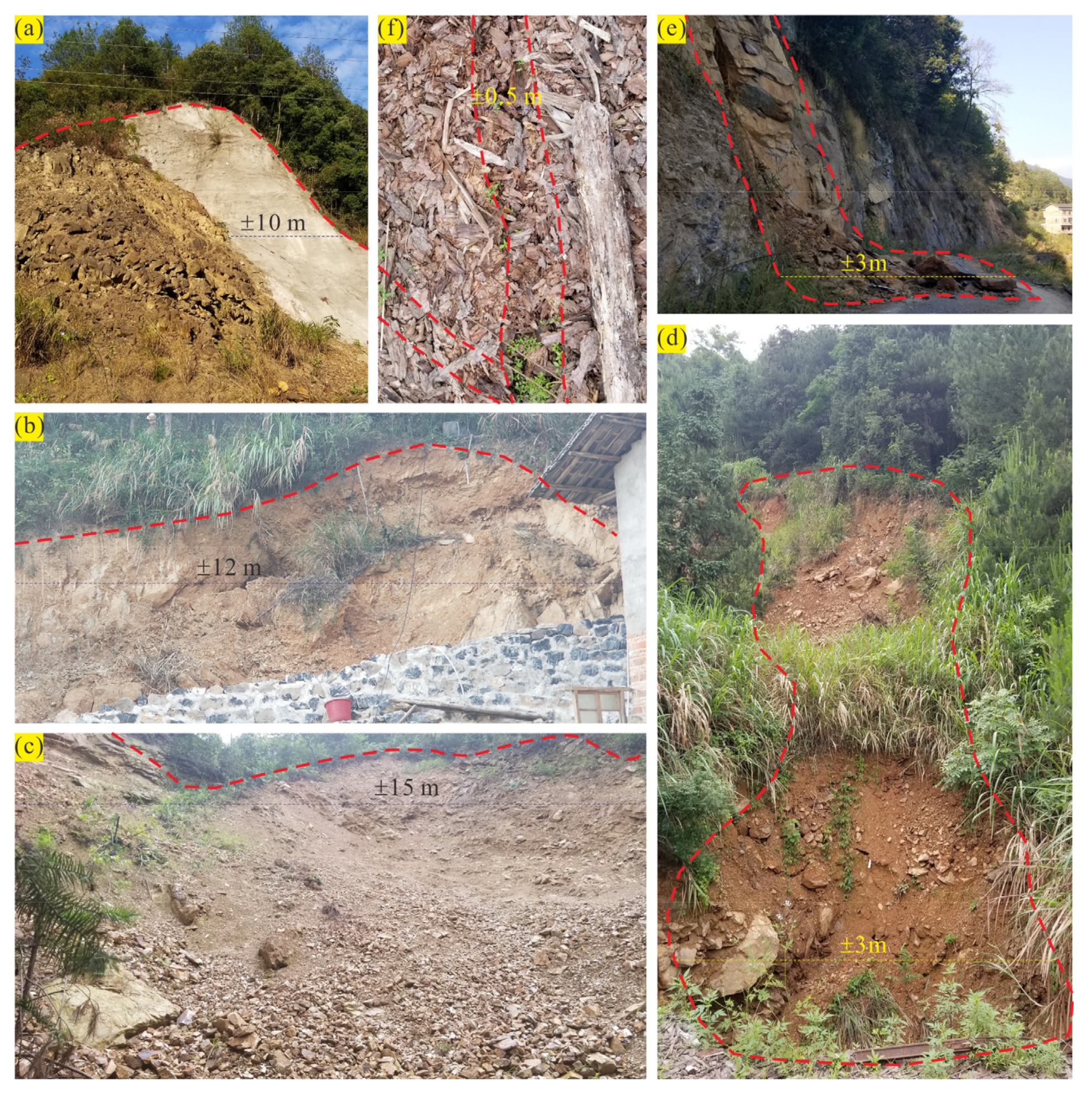
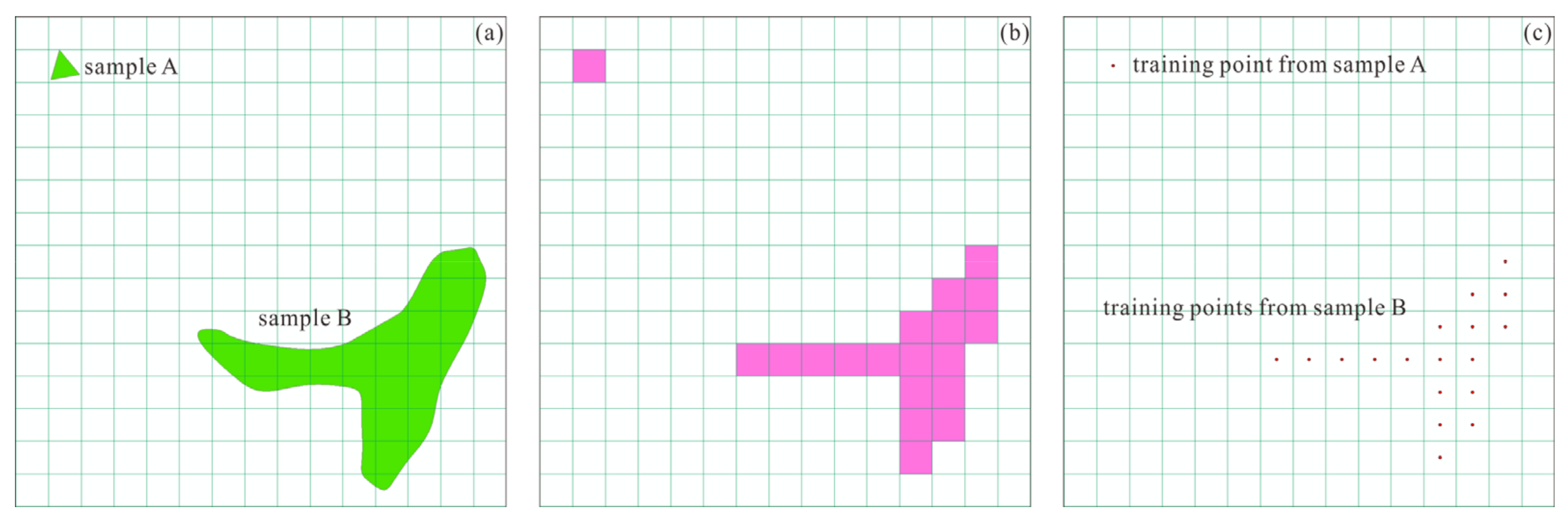
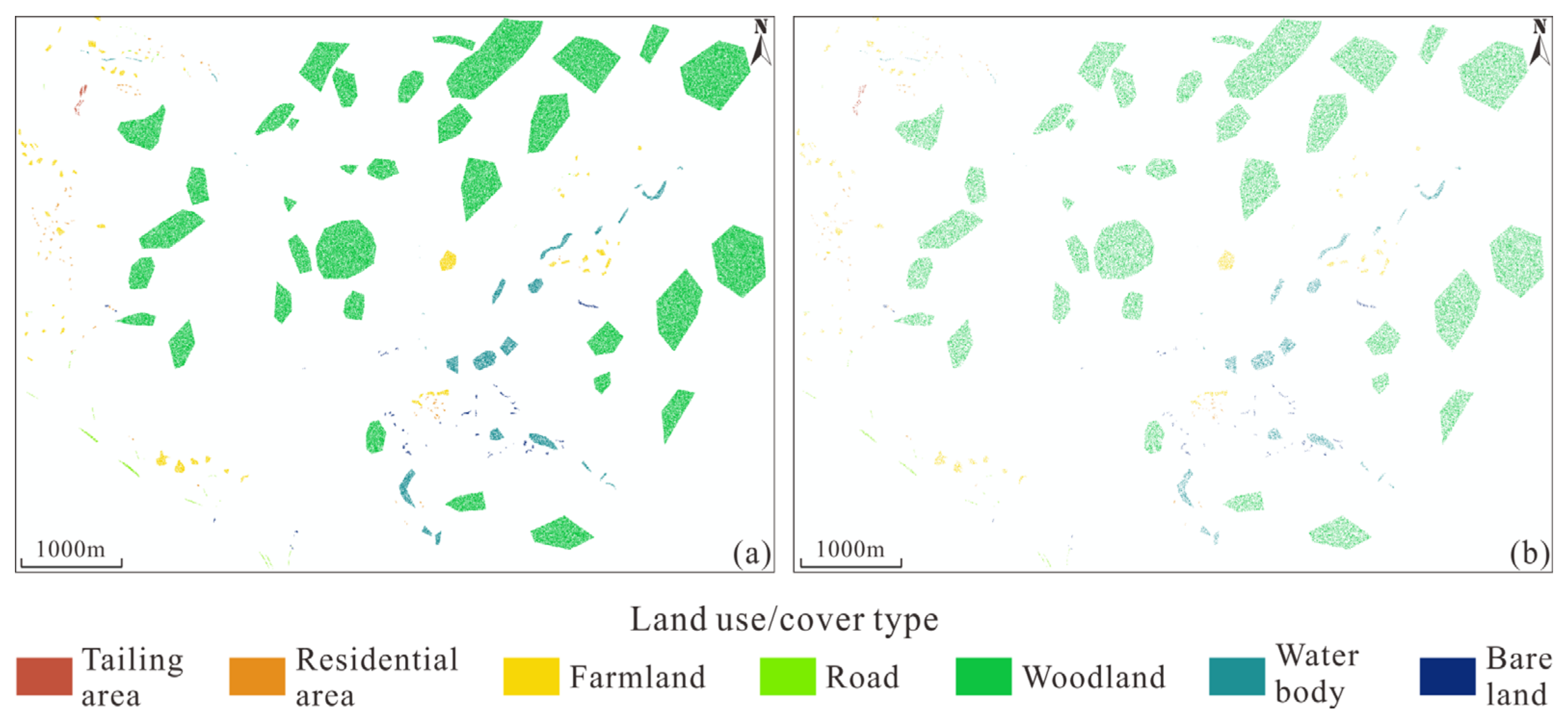
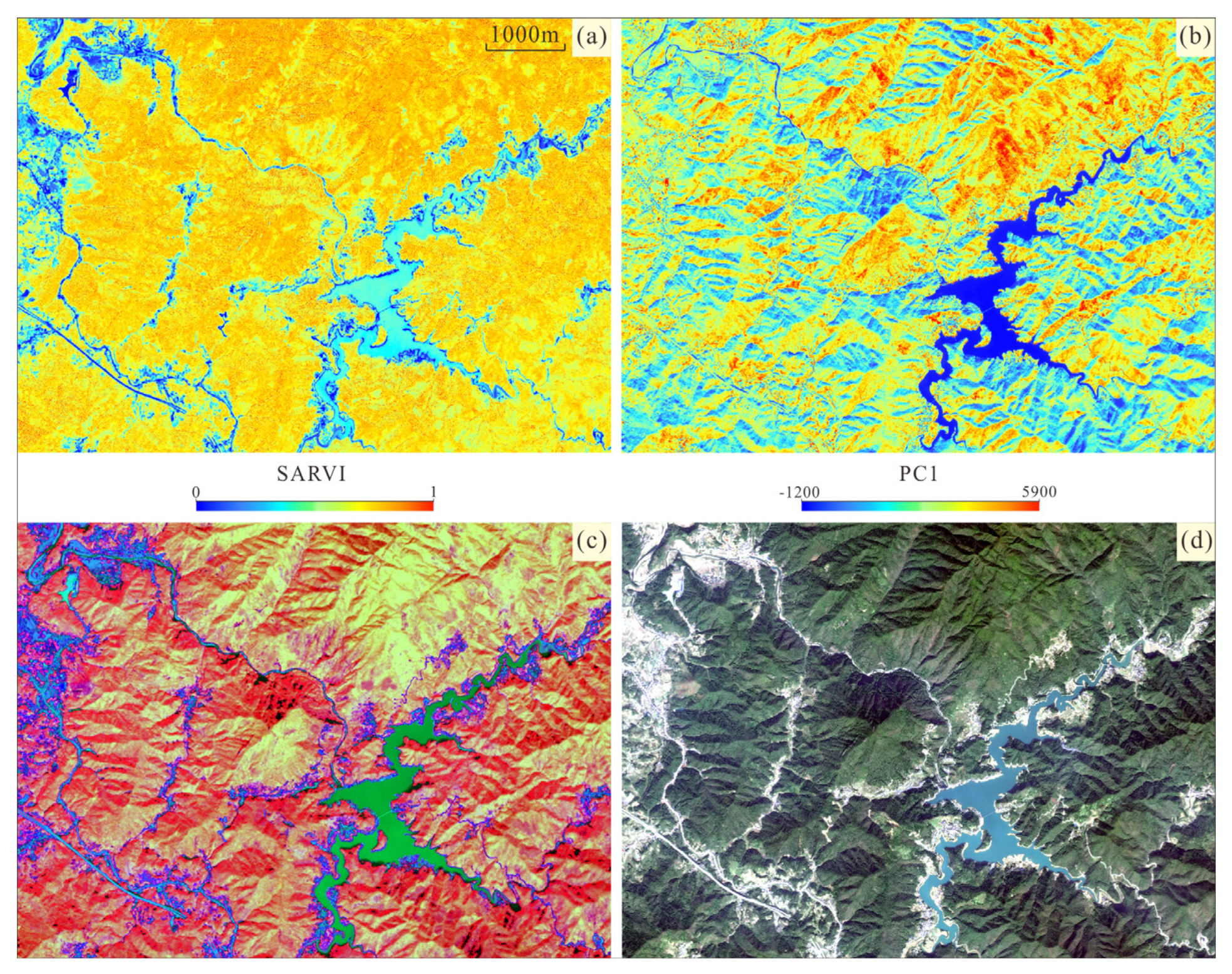



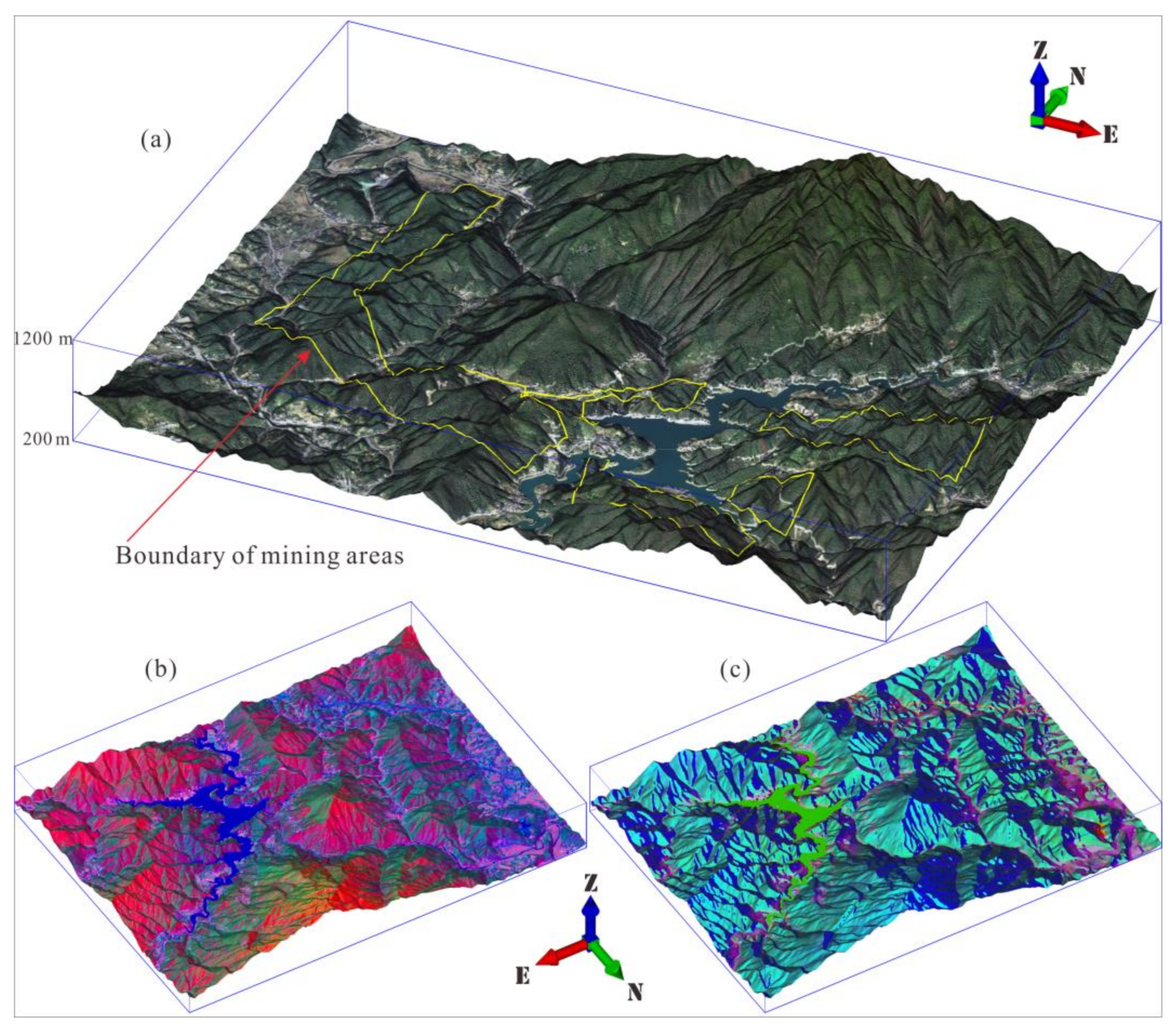
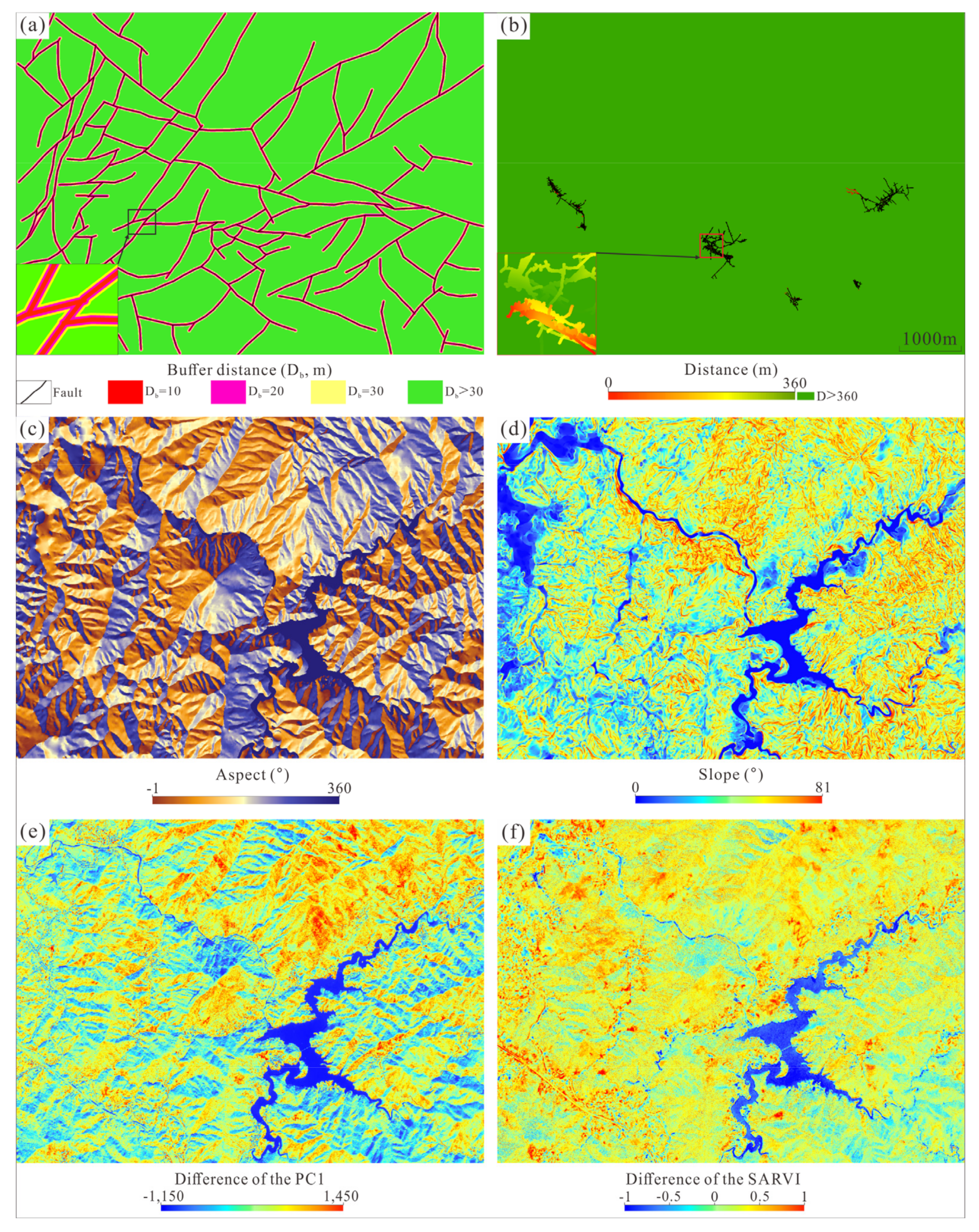


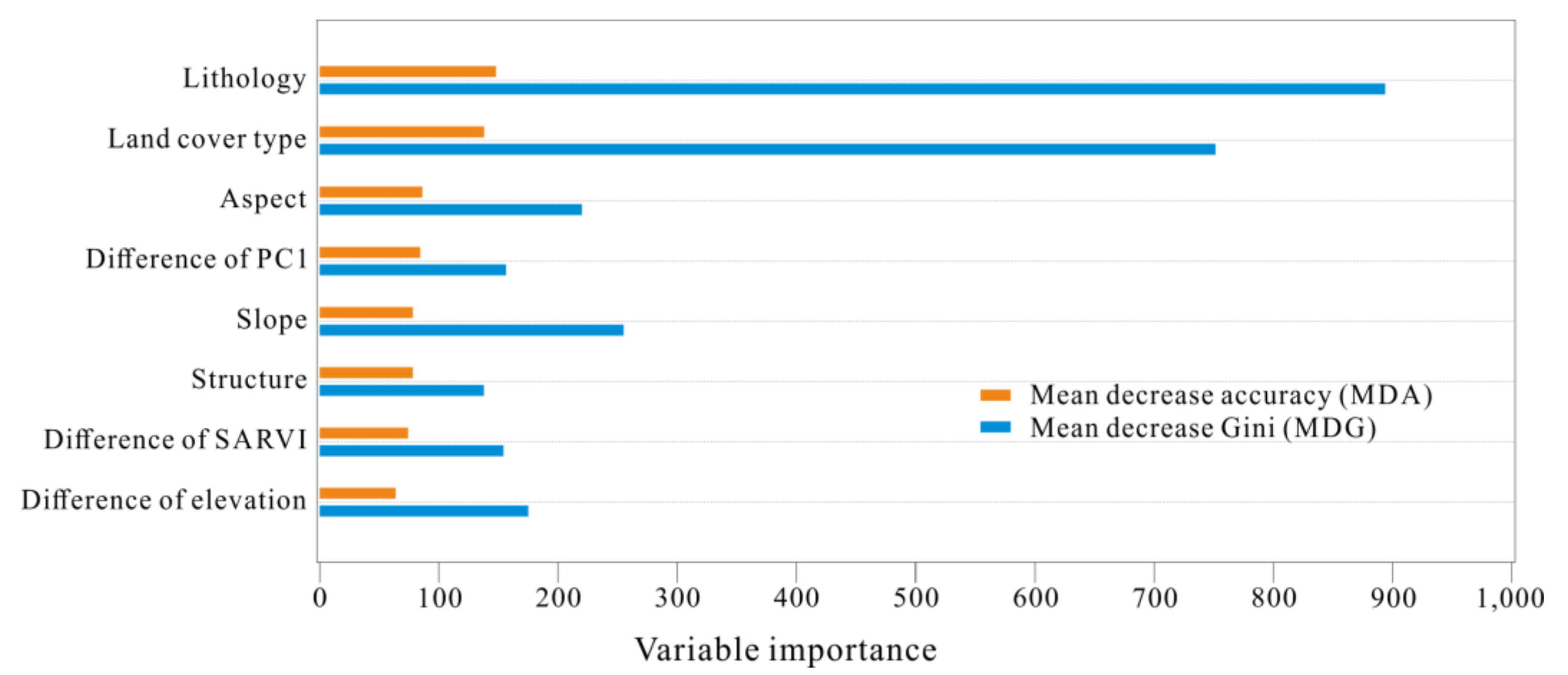
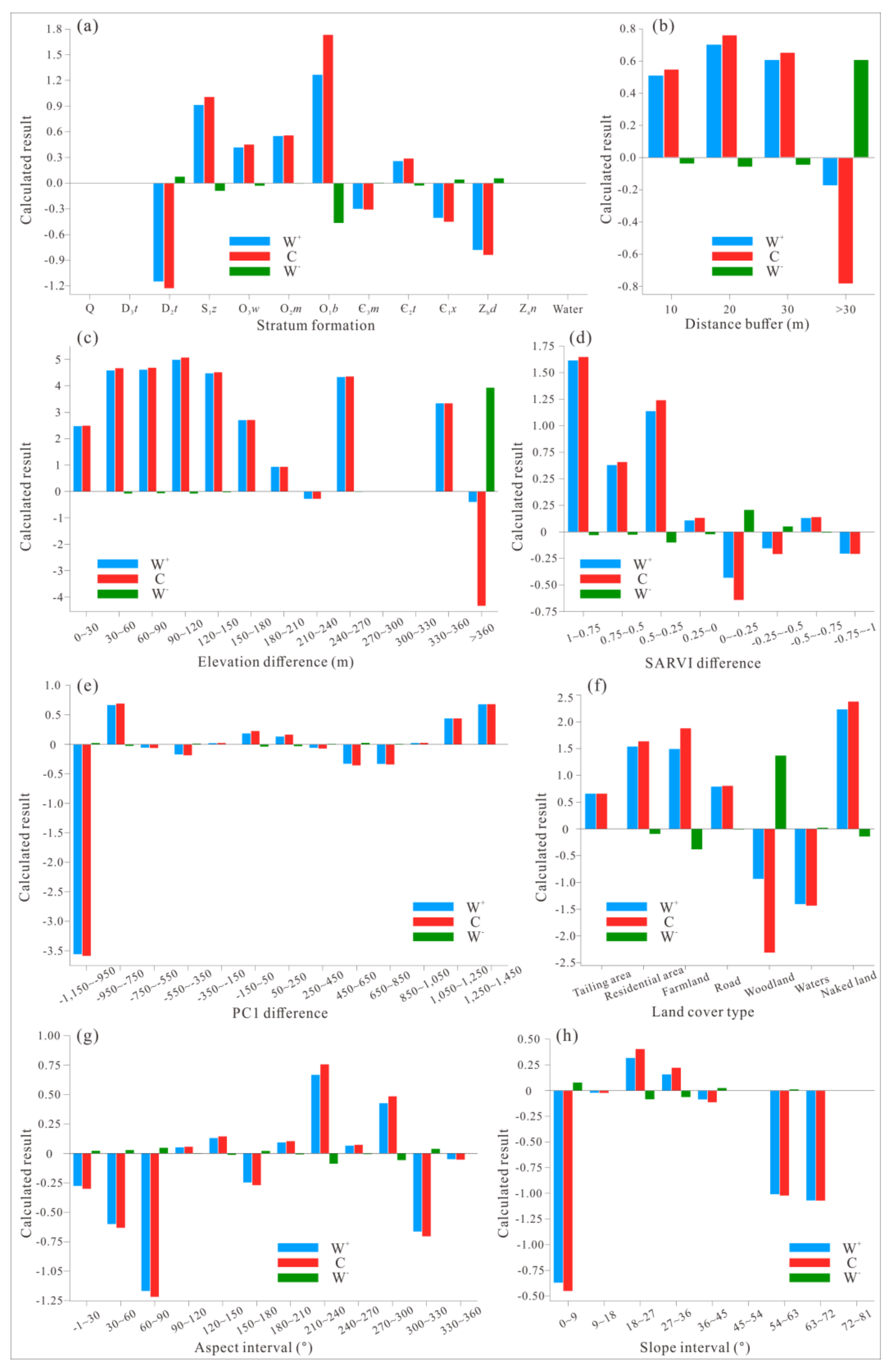
| Epoch | Lithological Unit | Code | Thickness and Lithological Composition |
|---|---|---|---|
| Quaternary | No | Q | 1~3 m. Eluvium and alluvium: thin clay and clayey soil. |
| Upper Devonian | Tianxin Formation | D3t | 180~400 m. Thin-bedded siltstone, silty shale. |
| Middle Devonian | Tiaomajian Formation | D2t | More than 660 m. Silty shale with siltstone interblended, thick fine-grained quartzose sandstone intercalated with siltstone and celadon shale. |
| Lower Silurian | Zhoujiaxi Formation | S1z | 64~375 m. Medium-thick fine sandstone intercalated with thin layered silty shale, carbonaceous fine sandstone with interlayers of the siltstone. |
| Upper Ordovician | Wufeng Formation | O3w | 5~28 m. Medium-bedded silty carbonaceous platy shale with intercalated siliceous bands. |
| Middle Ordovician | Modao Formation | O2m | 48~80 m. Carbon-bearing silicate with thin silty shale interblended. |
| Lower Ordovician | Baishuixi Formation | O1b | 150~520 m. Gray plate shale locally intercalated with carbon-bearing mudstone and siliceous bands. |
| Upper Cambrian | Miliangpo Formation | Є3m | 140~320 m. Crystal powder limestone intercalated with siliceous bands. |
| Middle Cambrian | Tanxi Formation | Є2t | 110-280 m. Gray banded marlstone and globular crystal powder limestone. |
| Lower Cambrian | Xiaoyanxi Formation | Є1x | 158~368 m. Carbonaceous mudstone intercalated with poor coal seam and siliceous bands. |
| Upper Sinian | Doushantuo Formation | Zbd | 70~121 m. Thin-bedded carbon-bearing mudstone, biomicrite, and silicate layered clearly. |
| Lower Sinian | Nantuo Formation | Zan | 100~680 m. Moraine conglomerate, conglomerate, and carbonate with the character of glaciomarine deposit. |
| Sensor | Spectral Band | Wavelength Range (µm) | Spatial Resolution (m) | |
|---|---|---|---|---|
| PMS | Panchromatic | B–1 (PAN) | 0.45–0.90 | 2 |
| Multispectral | B–2 (Blue) | 0.45–0.52 | 8 | |
| B–3 (Green) | 0.52–0.59 | |||
| B–4 (Red) | 0.63–0.69 | |||
| B–5 (NIR) | 0.77–0.89 | |||
| Classification | No. of Samples for | Sample Proportion | ||
|---|---|---|---|---|
| Training | Validation | In Sample Set | In Study Area | |
| Tailing area | 1258 | 545 | 0.183 | 0.017 |
| Residential area | 3252 | 1412 | 0.472 | 0.045 |
| Farmland | 22,904 | 9618 | 3.293 | 0.315 |
| Road | 2718 | 1164 | 0.393 | 0.038 |
| Woodland | 621,245 | 266,578 | 89.902 | 8.609 |
| Water body | 35,801 | 15,346 | 5.179 | 0.496 |
| Bare land | 4108 | 1594 | 0.577 | 0.055 |
| Class | Confusion Matrix (No. of grid cells) | F1 Score (%) | |||||||
|---|---|---|---|---|---|---|---|---|---|
| Class1 | Class2 | Class3 | Class4 | Class5 | Class6 | Class7 | Sum | ||
| Tailing area | 536 * | 1 | 0 | 2 | 0 | 0 | 6 | 545 | 98.80 |
| Residential area | 0 | 1333 | 1 | 14 | 0 | 4 | 60 | 1412 | 95.01 |
| Farmland | 0 | 7 | 9356 | 5 | 138 | 0 | 112 | 9618 | 96.33 |
| Road | 1 | 3 | 0 | 1131 | 0 | 0 | 29 | 1164 | 97.16 |
| Woodland | 0 | 22 | 439 | 0 | 266,110 | 1 | 6 | 266,578 | 99.89 |
| Waters | 0 | 7 | 0 | 0 | 0 | 15,339 | 0 | 15,346 | 99.96 |
| Naked land | 3 | 21 | 10 | 12 | 0 | 0 | 1548 | 1594 | 92.28 |
| Sum | 540 | 1394 | 9806 | 1164 | 266,248 | 15,344 | 1761 | 296,257 | - |
| Susceptibility Class | Probability Interval (P, %) | Proportion of the Predictive Data (%) | Proportion of the Samples (%) | Occurrence Rate of the Samples (%) |
|---|---|---|---|---|
| High | P ≥ 90.59% | 2.82 | 85.60 | 7.23 |
| Middle | 90.59% > P ≥ 77.26% | 5.28 | 8.08 | 0.36 |
| Low | 77.26% > P ≥ 50.20% | 12.11 | 6.07 | 0.12 |
| Stable | P < 50.20% | 79.79 | 0.25 | 0 |
Publisher’s Note: MDPI stays neutral with regard to jurisdictional claims in published maps and institutional affiliations. |
© 2021 by the authors. Licensee MDPI, Basel, Switzerland. This article is an open access article distributed under the terms and conditions of the Creative Commons Attribution (CC BY) license (https://creativecommons.org/licenses/by/4.0/).
Share and Cite
Qin, Y.; Cao, L.; Darvishi Boloorani, A.; Wu, W. High-Resolution Mining-Induced Geo-Hazard Mapping Using Random Forest: A Case Study of Liaojiaping Orefield, Central China. Remote Sens. 2021, 13, 3638. https://doi.org/10.3390/rs13183638
Qin Y, Cao L, Darvishi Boloorani A, Wu W. High-Resolution Mining-Induced Geo-Hazard Mapping Using Random Forest: A Case Study of Liaojiaping Orefield, Central China. Remote Sensing. 2021; 13(18):3638. https://doi.org/10.3390/rs13183638
Chicago/Turabian StyleQin, Yaozu, Li Cao, Ali Darvishi Boloorani, and Weicheng Wu. 2021. "High-Resolution Mining-Induced Geo-Hazard Mapping Using Random Forest: A Case Study of Liaojiaping Orefield, Central China" Remote Sensing 13, no. 18: 3638. https://doi.org/10.3390/rs13183638
APA StyleQin, Y., Cao, L., Darvishi Boloorani, A., & Wu, W. (2021). High-Resolution Mining-Induced Geo-Hazard Mapping Using Random Forest: A Case Study of Liaojiaping Orefield, Central China. Remote Sensing, 13(18), 3638. https://doi.org/10.3390/rs13183638









